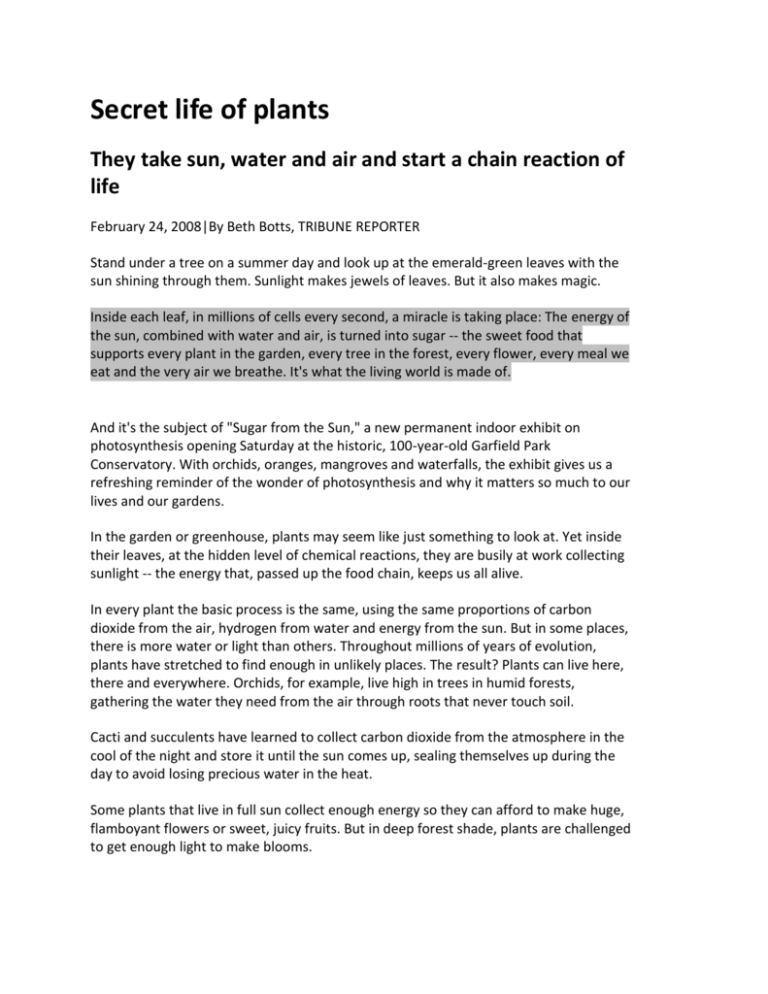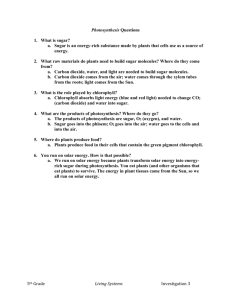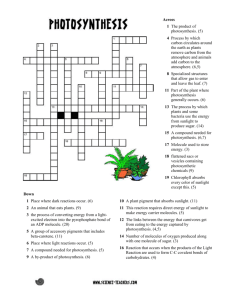Secret life of plants
advertisement

Secret life of plants They take sun, water and air and start a chain reaction of life February 24, 2008|By Beth Botts, TRIBUNE REPORTER Stand under a tree on a summer day and look up at the emerald-green leaves with the sun shining through them. Sunlight makes jewels of leaves. But it also makes magic. Inside each leaf, in millions of cells every second, a miracle is taking place: The energy of the sun, combined with water and air, is turned into sugar -- the sweet food that supports every plant in the garden, every tree in the forest, every flower, every meal we eat and the very air we breathe. It's what the living world is made of. And it's the subject of "Sugar from the Sun," a new permanent indoor exhibit on photosynthesis opening Saturday at the historic, 100-year-old Garfield Park Conservatory. With orchids, oranges, mangroves and waterfalls, the exhibit gives us a refreshing reminder of the wonder of photosynthesis and why it matters so much to our lives and our gardens. In the garden or greenhouse, plants may seem like just something to look at. Yet inside their leaves, at the hidden level of chemical reactions, they are busily at work collecting sunlight -- the energy that, passed up the food chain, keeps us all alive. In every plant the basic process is the same, using the same proportions of carbon dioxide from the air, hydrogen from water and energy from the sun. But in some places, there is more water or light than others. Throughout millions of years of evolution, plants have stretched to find enough in unlikely places. The result? Plants can live here, there and everywhere. Orchids, for example, live high in trees in humid forests, gathering the water they need from the air through roots that never touch soil. Cacti and succulents have learned to collect carbon dioxide from the atmosphere in the cool of the night and store it until the sun comes up, sealing themselves up during the day to avoid losing precious water in the heat. Some plants that live in full sun collect enough energy so they can afford to make huge, flamboyant flowers or sweet, juicy fruits. But in deep forest shade, plants are challenged to get enough light to make blooms. Most photosynthesis takes place inside leaves, but some plants have learned to make their food in stems. Others scrabble out their lives as a fuzz of green moss on rocks. That diversity is what makes gardening interesting. We can find plants of a thousand forms that will live in whatever kind of sunlight we have, even if it's the shade of tall trees or buildings. Some plants will even live inside our houses. But they all need some light from our nearest star to work their magic. --How do they do that? A gardener wandering through "Sugar from the Sun" might find a few things to ponder. Epiphytes on high: Look up, says conservatory educational programming director Melanie Harding. You'll see epiphytes, such as orchids and air plants, dangling overhead. In nature, they would live on trees or perch on rocks, collecting the water they need from humid air. They gather the carbon dioxide they need to make their food from the air too. Gotta be green: Why is most of the room the same color? Because photosynthesis takes place in chloroplasts, tiny cellular organs that operate on the green chemical chlorophyll. In some plants, the green is masked with red or yellow pigments, but that doesn't block sunlight or affect photosynthesis, says Brian Capon, author of "Botany for Gardeners" (Timber Press, 239 pages, $19.95). In white-variegated plants, though, such as some hostas or dogwoods, chlorophyll is missing from the white parts of a leaf. No chlorophyll, no photosynthesis -- so the plant likely will need more sunlight on its green parts to make up for the lack. What's for lunch: The sugar plants make is their food. Fertilizer (even when it's labeled as "plant food") doesn't really feed plants; it just provides some useful minerals that improve the diet, rather like a multivitamin tablet. But you can't live on vitamins and plants don't live on fertilizer. They live by breaking down the sugar they have made for the energy it holds in its chemical bonds. Go with the flow: Like that waterfall? Every plant -- even a cactus -- works on water. Water pressure in their cells makes soft-tissue plants stand up. Water vapor evaporating from the leaves creates a vacuum that pulls liquid water, with dissolved nutrients, up into the leaves from the roots. Sugar dissolved in water flows to the parts of the plant that need the energy. Some plants have learned to get by with amazingly little water, but even cacti need some. Thanks for the oxygen: Photosynthesis produces not only sugar, but oxygen. With the energy of sunlight, carbon and oxygen from a carbon dioxide molecule are combined with a hydrogen atom cracked off of a water molecule and turned into a carbohydrate -sugar. Oxygen molecules are left over. Scientists say plants gave us all the oxygen we breathe, releasing it into the atmosphere over 3.5 billion years of photosynthesis. They also say we badly need plants to help soak up the excess carbon dioxide we've pumped into the air over the last few centuries. More sun, more blooms: Making flowers (such as the guzmania, right) takes a lot of energy. So does creating seeds or bulbs. A plant only can spend as much energy as it can collect from light, so flowering plants tend to need full sun. Blooms in deep shade are rare. What grows beneath: Look around the exhibit -- at the mangroves in the pond, or the banyan or balsam apple trees -- and you'll see roots growing right out of the trunk. Orchids and Spanish moss also have air roots. We think of roots as growing in soil, but they don't have to; their job is to collect water for the chloroplasts and nutrients for the plant's general health, and if the air is humid enough, the roots can bypass soil. In our climate, though, most plants sink their roots in soil -- for anchoring, for protection in cold winters and hot summers, and to cooperate with tiny underground organisms for the benefit of both. How sweet it is: Plants also use sugar for nectar, to attract insects to pollinate their flowers, and for fruits, encasing seeds in sweet flesh. When a bird eats a berry, it distributes the seed. We benefit too: In the exhibit you'll find pineapples, oranges, lemons and banana trees. Sugar storehouse: Plants can use their sugar right away, or they can store it for later by transforming it into more stable starch (think potatoes). They also can use the energy to create fats (think olives) and protein (think beans). Roots are a major storehouse for starch. So when we whack away at the roots of trees or perennials in transplanting, we are cutting off much of their food reserves -- one reason it's so hard for plants to get over being moved. Info: 773-638-1766, ext. 13; garfield-conservatory.org/sugar.htm ---------ebotts@tribune.com









